Feature
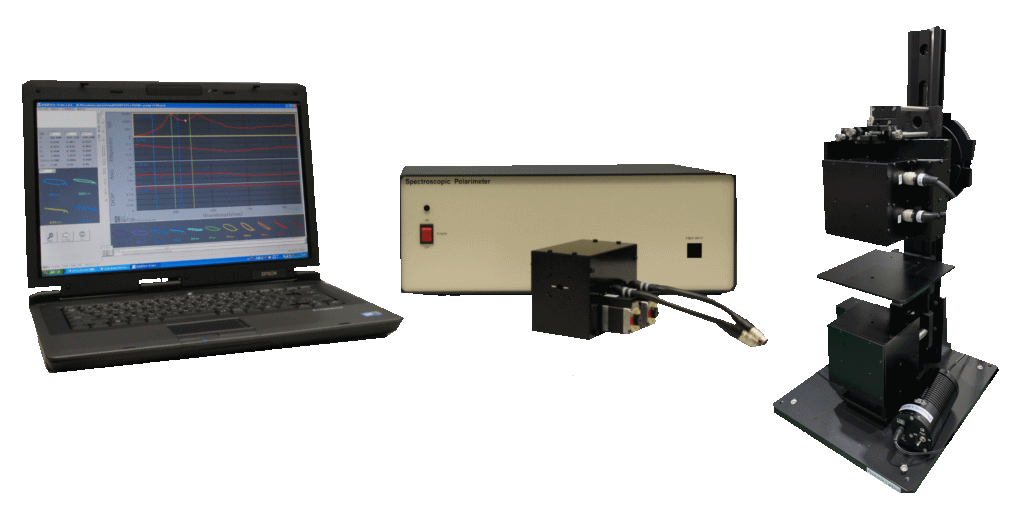
Spectroscopic Polarimeter Sci-Ral
Multifunctional polarization measuring system for spectroscopic measurement of light polarization state, birefringence (R0, Rth), and Mueller matrix
The spectroscopic polarimeter “Sci-Ral” can measure spectroscopic (multi-wavelength) polarization characteristics of optical materials, including the polarization state of light and birefringence, over a wide wavelength range (400 to 800nm) and with a wavelength resolution of 2nm.
In addition, the function can be expanded to measure birefringence (retardation and early (late) axes) of retardation films used in displays, and to measure Mueller matrices that can evaluate polarization characteristics other than birefringence (dichroism, optical rotation, depolarization).
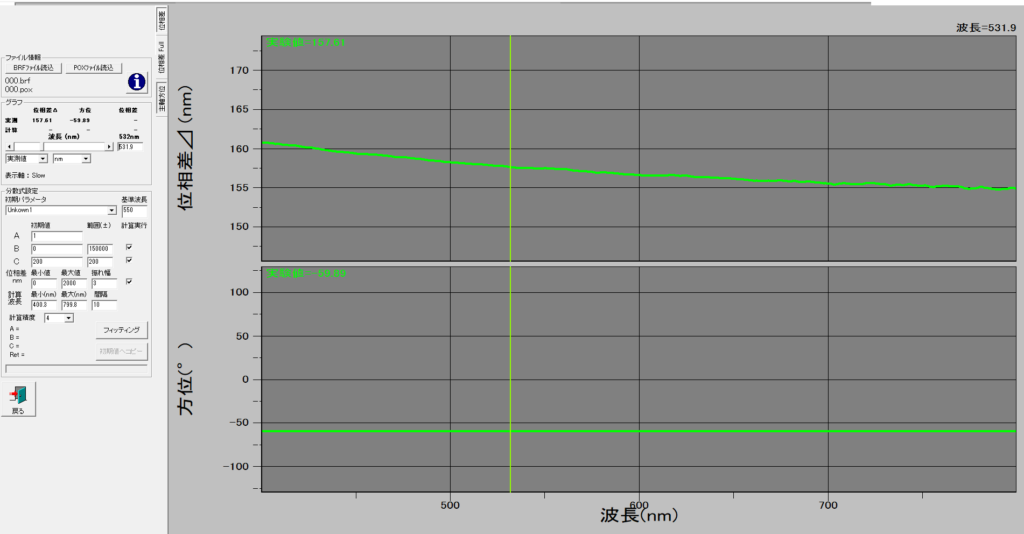
Birefringence Measurement
The dispersion of retardation (Wavelength dependence of retardation) due to birefringence of display materials such as optical films and optical elements such as waveplates can be measured and evaluated. Spectroscopy allows us to identify the wavelength at which the measured λ/4 retardation film functions correctly.
(From the top: Retardation at each wavelength and slow axis).
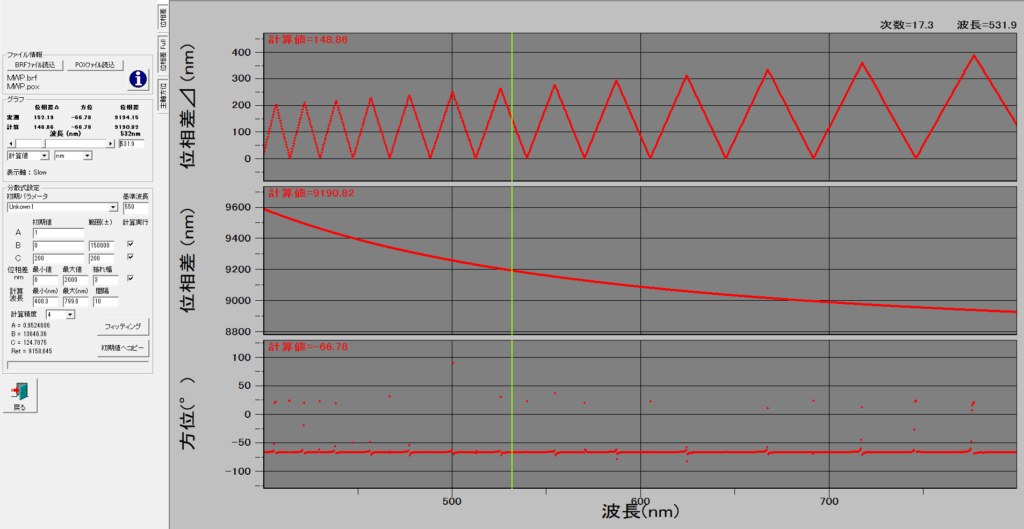
Some optical components, such as viewing angle improvement films for displays, have very large retardation. This equipment can analyze retardation of tens of thousands nm or more with its fitting function. In addition, accurate retardation can be obtained by using the fitting curve even for retardation near λ/2nm, which cannot be measured by the instrument.
( From the top: Measured retardation, actual retardation after fitting (9190nm@λ532nm),show axis).
Rth Measurement
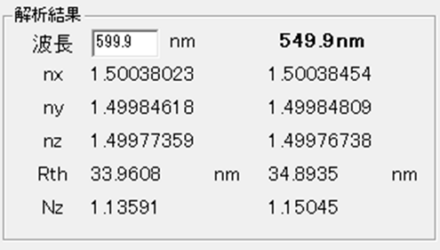
Mueller matrix Measurement
The Mueller matrix is a 4×4 matrix of parameters covering the polarization properties of materials and optical systems. Sci-Ral measures the full Mueller matrix at each wavelength, so the Mueller matrix is displayed as 4×4=16 graphs. Sci-Ral includes the ability to separate analysis from the Mueller matrix into polarization properties such as birefringence, dichroism, optical rotation, and Depolarization. In addition, the Mueller matrix can be used to trace the polarization state after passing through a material or optical system by assuming the incident polarization.
●Measurement example 1:Optical element evaluation
By analyzing polarization from the Mueller matrix of a waveplate (Retardation plate), it is possible to evaluate any polarization characteristics other than retardation and fast (slow) axis due to birefringence. Some broadband waveplates are known not only retardation but also fast (slow) axis changes with wavelength. Furthermore, the presence or absence of optical rotation (a property in which linear polarization rotates), which is not seen in general waveplates, can be evaluated.
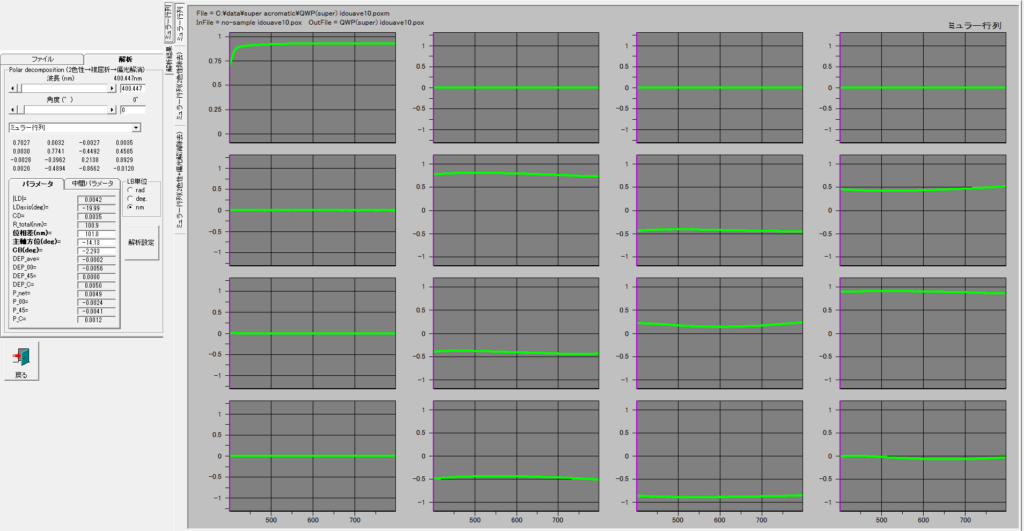
Mueller matrix
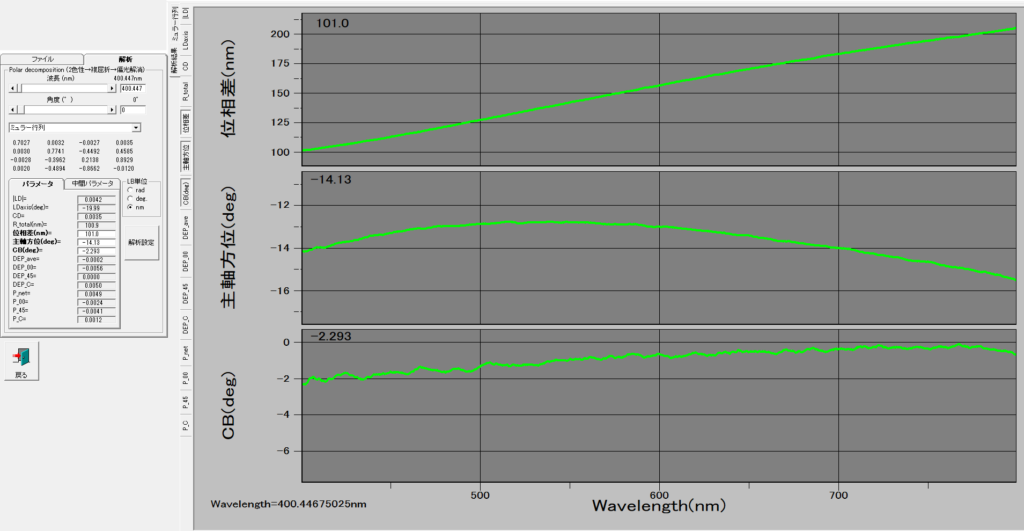
Analysis results
( From the top: Retardation, fast axis, optical rotation )
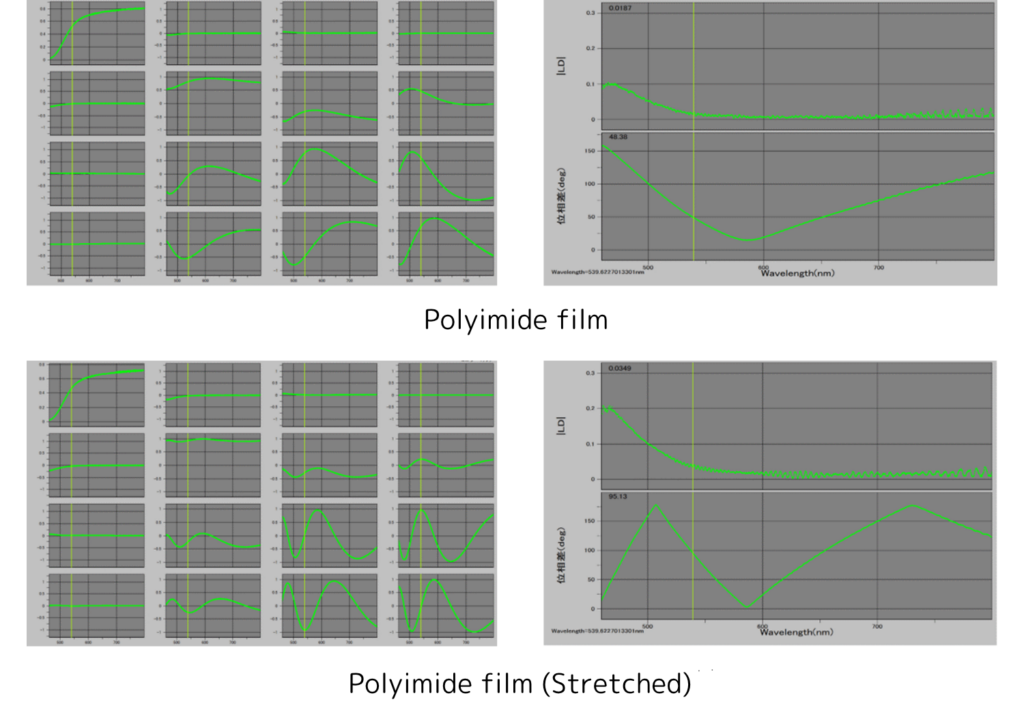
●Measurement example 2:Polyimide film
Aromatic polyimides absorb light at short wavelengths, giving them a brown color, and The measured films absorb light at wavelengths around 400-500nm. Mueller matrix analysis makes it possible to separately evaluate dichroism at the absorption wavelength and retardation due to birefringence. This type of analysis is said to make it possible to evaluate the internal structure of materials from multiple angles at both the micro (molecular size) and macro (submicron size) levels. Left image: Mueller matrix Right image: Analysis results
From the top: Dichroism, Retardation
Polarization (Stokes) Measurement
Spectroscopic measurements are made of four values from S0 to S3, called Stokes vectors, which represent the polarization state of light. In addition, to make it easier to understand the polarization state, the ellipticity, which indicates the shape of the (elliptical) polarized light, the axial direction which indicates the direction of the major axis, and the degree of polarization, which indicates the ratio of polarized and unpolarized light, are also displayed. In addition, the Poincaré sphere and polarization state are displayed in illustrations, allowing you to intuitively understand the polarization state.

●Measurement example 1:Circular polarizer
Measuring a Circular polarizer reveals the following:
・Identification of left-right rotation direction of circularly polarized light.
・Wavelength that becomes completely circularly polarized light.
・Wavelength range in which it functions as a circular polarizing plate.
From the top: Ellipticity, polarization axis direction, degree of polarization.
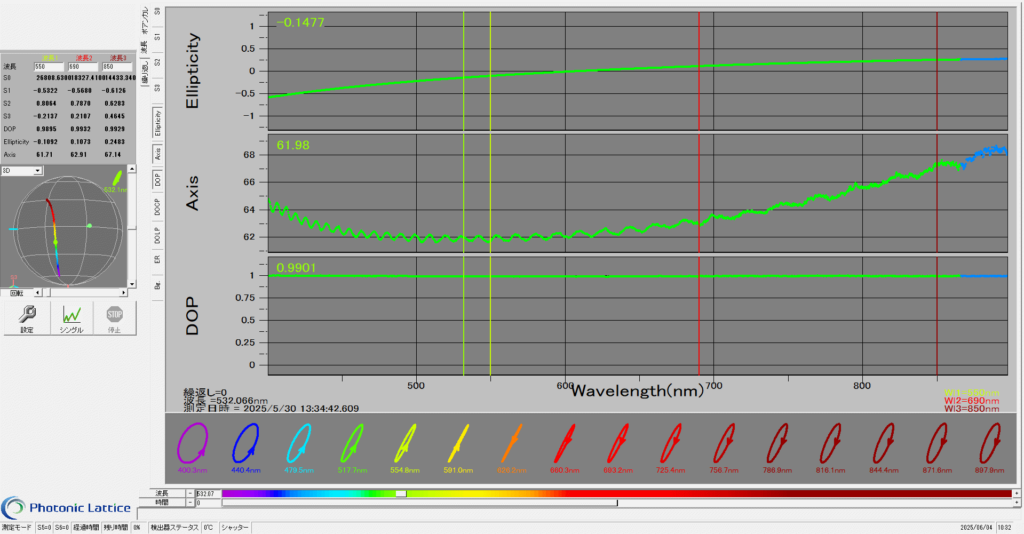
●Measurement example 2:Waveplate (Retardation plate)
This is the outgoing polarization when linearly polarized light is incident on a zero-order crystal waveplate. The structure of the quartz waveplate (lamination angle error between two quartz crystals or crystal inhomogeneity) affects the polarization state, causing it to oscillate finely in the wavelength direction.
From the top: Ellipticity, polarization axis direction, degree of polarization.
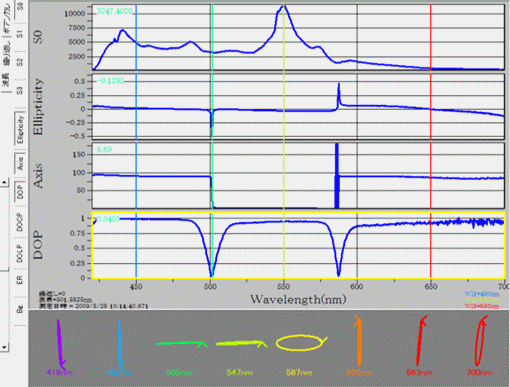
●Measurement example 3:Optical System
It is possible to measure not only the optical element itself, but also the polarization state after passing through an optical system that is composed of various optical elements. The results shown in the figure are measurements of the projected light from an LCD projector with a built-in polarizing beam splitter. The polarization direction differs by 90 degrees for red (wavelengths 580nm or more), green (wavelengths 500 to 580nm), and blue (wavelengths 500nm or less). In addition, the degree of polarization is reduced where the three colors meet.
From the top: Stokes vector S0, ellipticity, polarization axis direction, degree of polarization.
●Measurement example 4:Reflected light measurement
It is known that the light reflected from scarab beetles is circularly polarized due to their surface structure. For example, if you observe the scarab beetle specimen in the photograph through a circular polarizing plate. When the specimen is irradiated with unpolarized light, a portion of the reflected light is measured to be left-elliptically polarized. Spectroscopy is particularly effective for this type of structurally induced polarization, as the wavelength at which the polarization properties appear changes depending on its structural geometry.

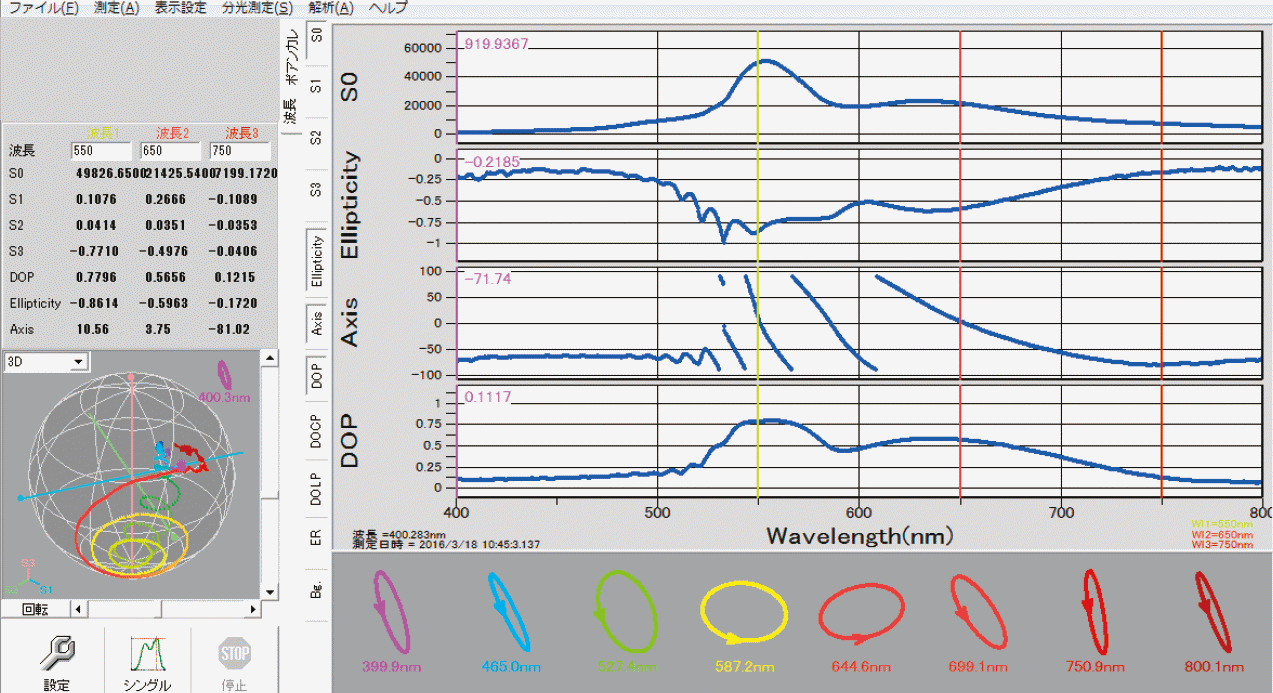
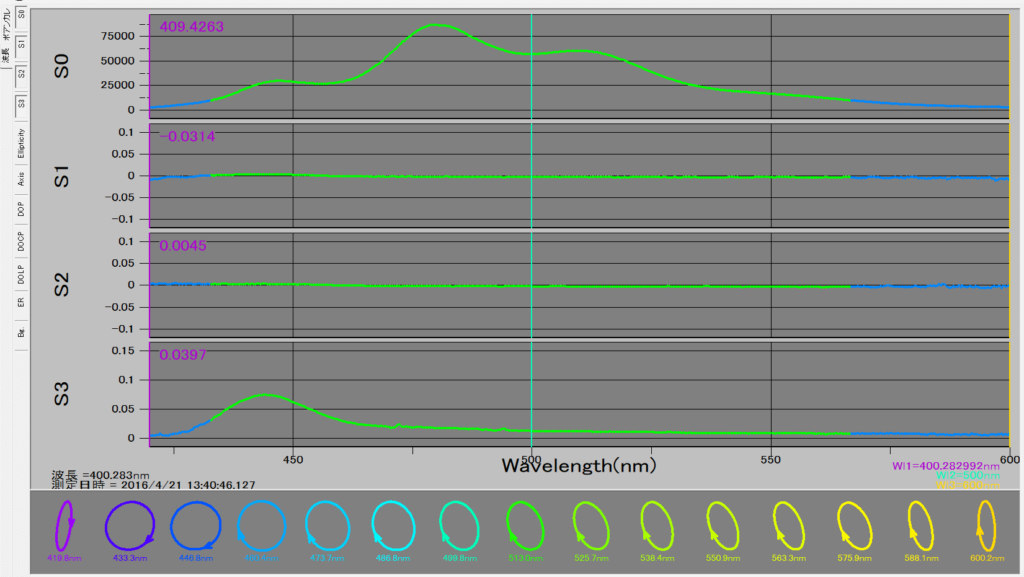
●Measurement example 5:Fluorescence measurements
It is possible to measure luminescence such as fluorescence. The results shown in the figure are PL (fluorescence) results, and circular polarization was detected in a right-handed cholesteric liquid crystal to which a fluorescent dye had been introduced. (S3 wavelength around 440nm).
(Tokyo university of science, Prof. Furumi)
From the top, the Stokes vectors S0, S1, S2 and S3
Customization
We can propose customizations based on the basic configuration to suit your specific application.
・Light Source
・Various optical components for sample measurement
・Transmission and reflection bench
Etc.
Please contact us using the inquiry form.
